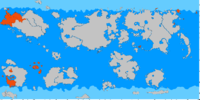Batavian Confederation: Difference between revisions
No edit summary |
|||
| Line 10: | Line 10: | ||
|capital = [['s Koningenwaarde]] <small>Statutory</small> | |capital = [['s Koningenwaarde]] <small>Statutory</small> | ||
|largecity = Kasterburg, [[Davignon]] | |largecity = Kasterburg, [[Davignon]] | ||
|lang = Batavian, Common Tongue, Martino | |lang = Batavian, Common Tongue, Martino and Catologian | ||
|religion= None official | |religion= None official | ||
|demnoun = Batavian | |demnoun = Batavian | ||
| Line 35: | Line 35: | ||
|drink = Dietish Wine | |drink = Dietish Wine | ||
}} | }} | ||
The '''Batavian Confederation''' (Batavian: Bataafse Bond) | The '''Batavian Confederation''' (Batavian: Bataafse Bond) was an association of autonomous states with a shared history, heritage and culture. Its founding members are [[Arcadia]], [[Batavia]] and the [[Beneluccas]]. Later Arcadia and the Beneluccas formed one kingdom and [[Helderbourgh]] joined as a member. In 1685, [[Los Liberados]] and [[Kasterburg]] left the confederation. | ||
The Confederacy was established during the early reign of King [[Arkadius IV]] in an attempt to increase political and cultural power of the Kingdom of Batavia. While it was clearly meant as a way to establish an independent faction to counter influences from both [[Jingdao]]'s and [[Shireroth]]'s alliances. | The Confederacy was established during the early reign of King [[Arkadius IV]] in an attempt to increase political and cultural power of the Kingdom of Batavia. While it was clearly meant as a way to establish an independent faction to counter influences from both [[Jingdao]]'s and [[Shireroth]]'s alliances. | ||
Latest revision as of 10:11, 27 December 2020
| Batavian Confederation | ||
| ||
| Motto: Eenheid in Verscheidenheid | ||
| Anthem: | ||

| ||
| Map versions | 16.4.7 - | |
| Capital | 's Koningenwaarde Statutory | |
| Largest city | Kasterburg, Davignon | |
| Official language(s) | Batavian, Common Tongue, Martino and Catologian | |
| Official religion(s) | None official | |
| Demonym | Batavian | |
| - Adjective | Batavian | |
| Government | Confederation | |
| - King of Batavia | Arkadius IV | |
| - Legislature | Bondsdag | |
| Establishment | 09.V.1669 | |
| Area | NA | |
| Population | 136,736,847 | |
| Currency | Batavian Kruys Golden Kruys Heldermark | |
| Abbreviation | BCF | |
| Time zone(s) | various | |
| National animal | Batavian lion | |
| National drink | Dietish Wine | |
The Batavian Confederation (Batavian: Bataafse Bond) was an association of autonomous states with a shared history, heritage and culture. Its founding members are Arcadia, Batavia and the Beneluccas. Later Arcadia and the Beneluccas formed one kingdom and Helderbourgh joined as a member. In 1685, Los Liberados and Kasterburg left the confederation.
The Confederacy was established during the early reign of King Arkadius IV in an attempt to increase political and cultural power of the Kingdom of Batavia. While it was clearly meant as a way to establish an independent faction to counter influences from both Jingdao's and Shireroth's alliances.
The Statute for the Batavian Confederation formulates the principle: “An armed attack on one of the confederate states is conceived as an attack on all confederate states of the Batavian Confederation”. As a result, the confederation is not only a curator of heritage and culture, but also a military alliance.
History
Background
In the years before the foundation of the confederation, there was a growing need for association of countries with a Batavian culture. During the golden age of the Second Kingdom of Batavia (1523 - 1579 AN), a precursor to the Batavian Confederation existed: the Batavian Commonwealth (1542 - 1551 AN). Countries such as the Grand Duchy of Aragon, the Grand Duchy of Nederburg and the Principality of Prussia were members of that commonwealth.
Another component in the need for the formation of a confederation is the policy of neutrality of the Raspur Pact and the Union of States around the Sovereign Oceans (USSO). Although there was no current threat, the principle of "an attack on one is an attack on all" was introduced.
In 1668 AN the first sketch of a statute for a new confederation in the Lagerhuis was submitted, the words were pronounced:
"In view of the proliferation of nations with a Batavian background, I think it is a good thing if a degree of unity can be achieved. The Batavian house has many rooms, but shares values and a history.In order to give this commitment a legal voice, I call for the establishment of a Batavian Confederation of Independent States. It is my hope that all Batavian states will join this union."
After a debate in the Lagerhuis, the current Statute for the Batavian Confederation was finally arrived at. Representatives of all founding members came to Willemspaleys to sign the statute. Thus the confederation became a fact.
Accession of Helderbourgh
There was already some affinity between Batavia and Helderbourgh, as Helderbourgh associated itself with the Batavian culture. In addition, the country has some areas that were once part of the Batavian Commonwealth. The heads of state of both countries maintained warm contact, after which Helderbourgh was invited to join the Batavian Confederation.
In the Bondsdag, the meeting of the Batavian Confederation, Helderbourgh was seen as a welcome addition, but there were reservations about the exit clause in the accession resolution. After Arkadius Frederik Gustavus des Vinandy was appointed Grand Duke, the Bundestag nevertheless agreed and Helderbourgh became a member of the confederation.
Unification of Arcadia and the Beneluccas
In 1673 AN the unification of the Kingdom of Arcadia and the Kingdom of Beneluccas to the United Kingdom Arcadia, the Beneluccas and the Land of the Calbain took place. As a result, the Beneluccas were no longer separate member of the confederation, but as part of the new kingdom.
Accession of Francia
When the Confederation wanted to be mentioned in one colour on the political map of the Micronational Cartography Society (MCS), there was talk of the rapid expansion of the Batavian influence on Micras. In addition, it was mentioned that Amokolia might also become a member of the Batavian Confederation. But the Amokolian diplomats said that membership of Amokolia is not to be expected.
The Kingdom of Amokolia was succeeded by the Frankish Empire, which in 1678 AN was attacked by various countries of the Raspur Pact. The Batavian Confederation became involved in the Second Amokolian War after Kasterburg joined the Frankish side in it, as well as the economic sanctions of various countries of the Raspur Pact against the members of the Batavian Confederation.
As a result, the Batavian Confederation and the Frankish Empire were more or less condemned to each other. This resulted in Francia's wish to become a member of the Batavian Confederation on 20.V.1679 AN. On 16.VIII.1679 AN the accession was a fact.
Member states
Current members
| Flag | State | Head of State | Date joined | Notes |
|---|---|---|---|---|
| United Kingdom of Arcadia, the Beneluccas and the land of the Calbain | Gustavus des Vinandy, King of Arcadia, Prince of Calbion | 1669 | Founding member, governed by the Batavian royal house of Vinandy. In 1673 AN the Kingdom of Arcadia and the Kingdom of the Beneluccas formed one kingdom. | |
| Kingdom of Batavia | Arkadius Frederik Gustavus des Vinandy, King of Batavia | 1669 | Most prominent member state, the Head of State of Batavia functions as Head of the Confederation. | |
| Grand Duchy of Helderbourgh | Arkadius Frederik Gustavus des Vinandy, Grand Duke of Helderbourgh | 1672 | At the invitation of the king of Batavia, because of the cultural ties between the two countries. At the time, Kilian Van Allen was the Grand Duke of Helderbourgh. Currently an autonomous region within the Kingdom of Batavia. | |
| Frankish Empire | Arkadius Frederik Gustavus des Vinandy, Kaiser von Francia | 1679 | In the aftermath of the Second Amokolian War, the Frankish Chancellor submitted the application for accession, on 16.VIII.1679 AN the accession was a fact. |
Former member
| Flag | State | Head of State | Period of membership | Notes |
|---|---|---|---|---|
| Kingdom of the Beneluccas | Margaery des Vinandy, Queen of the Beneluccas | 1669-1673 | Founding member, governed by the Batavian royal house of Vinandy. The country became part of the United Kingdom of Arcadia, the Beneluccas and the land of the Calbain. | |
| Kasterburg Republic | Reginald de Montfort, Magistrate of the Kasterburger Republic | 1669-1685 | Founding member. Until 1680 an autonomous region within the Kingdom of Batavia. | |
| Republic of Los Liberados | Rodrigo Calderon Mendez, President of the National Liberation Council | 1669-1676 1678-1685 |
Founding member coinciding with its independence from Kasterburg. The membership ended when the country became a protectorate of the Florian Republic. But after independence, the country became a member of the confederation again. |
Organisation
At the head of the Batavian Confederation is the King of Batavia, the chairman for the meetings of the Bondsdag (Federal Diet). The Bondsdag is the joint meeting of all confederate states. The meetings of the Bondsdag take place in the Paleys Raiselle.
The Statute for the Batavian Confederation forms the basis of the Batavian Confederation. The provisions of the confederation are expressed in resolutions:
- Number 01: Resolution on the map of the Micronational Cartography Society
- Number 02: Resolution on the accession of the Grand Duchy of Helderbourgh
- Number 03: Resolution on the flag of de Batavian Confederation
